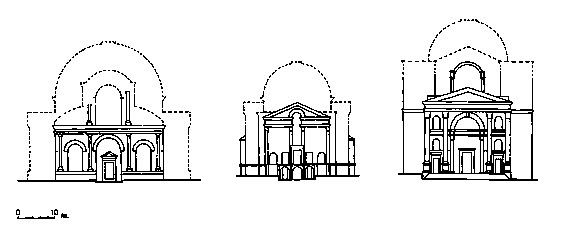
|
The Numberable Architecture of Leon Battista
Alberti as a Universal Sign of Order and Harmony |
|---|
Mantua, ITALY
Assuming responsibility for the restoration of the Basilica of S. Andrea in Mantua, I sought to discover how much of the project conceived by Alberti is discernible today. The intimate relationships between number and architecture have been interpreted in many different ways. One school envisions Alberti as champion of the tranquil humanism of Cicero and creator of universal harmonies, emphasizing musical relationships. Another school proposes an interpretative model based on the use of geometric systems of proportions. Whatever the point of view, Alberti's design method resulted in the perfect fit of the parts, which will concatenate only if expressed in a certain way.

Schematic diagrams of the facades of S. Francesco (Rimini), S. Sebastiano (Mantua), and S. Andrea (Mantua).
My analysis of San Sebastiano in Mantua illustrates such a concatenating system. A sixteenth century drawing offers a fundamental key for the interpretation. All values of the principle dimensions of the building may be encompassed in a system of a few mathematical relationships. The internal measurements in braccia of the central square, the arms of the cross, and the portico, form the following three numerical progressions:
| (a) | 34,(34), | 56-2/3 |
| (b) | 12, 20, | 33-1/3 |
| (c) | 10, | 16-2/3 |
A fourth series is formed from the dimensions of the main entrance portal and the absidioles:
| (d) | 4-4/5, 8, | 13-1/3 |
All four sequences take their rhythm from the relationship 3:5. Consequently, all of the dimensions of the drawing make up a well-defined group, forming duads or triads in the ratio of 3:5. The link between the fundamental dimensions for the the portico, arms and square of the upper church (10, 20, and 34) is found in the series of the squares of the first five integers, as the sums of squares of either odd or even numbers.
These facts constitute a solid base for the study of the Albertian design method: the dimensions of the architectural elements are determined by finite ratios; the dimensions are interrelated by mathematical (but not musical) progressions; the measurements create numerically proportionate triads, which are themselves proportionately interrelated. Perfect order, harmony, in which number links the visible to the invisible: mathematical order is not only the order of the divine, but also the basis for any order that can be achieved in reality.
|
Livio Volpi Ghirardini "The Numberable Architecture of Leon Battista Alberti as a Universal Sign of Order and Harmony", pp. 147-166 in Nexus: Architecture and Mathematics, ed. Kim Williams, Fucecchio (Florence): Edizioni dell'Erba, 1996. http://www.nexusjournal.com/conferences/N1996-Volpi.html |
|
|
|
|
